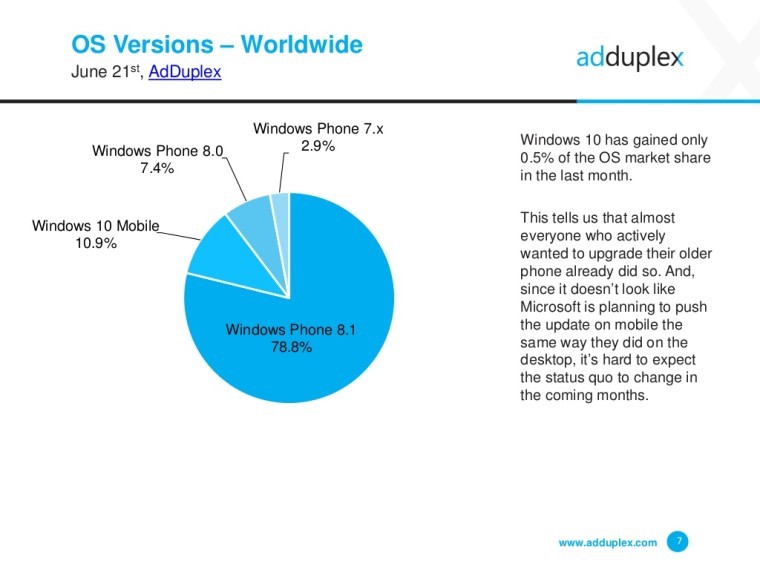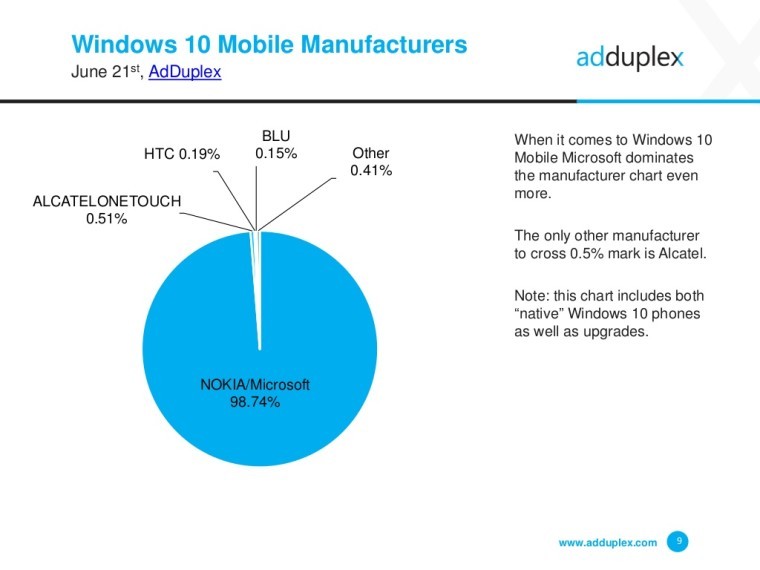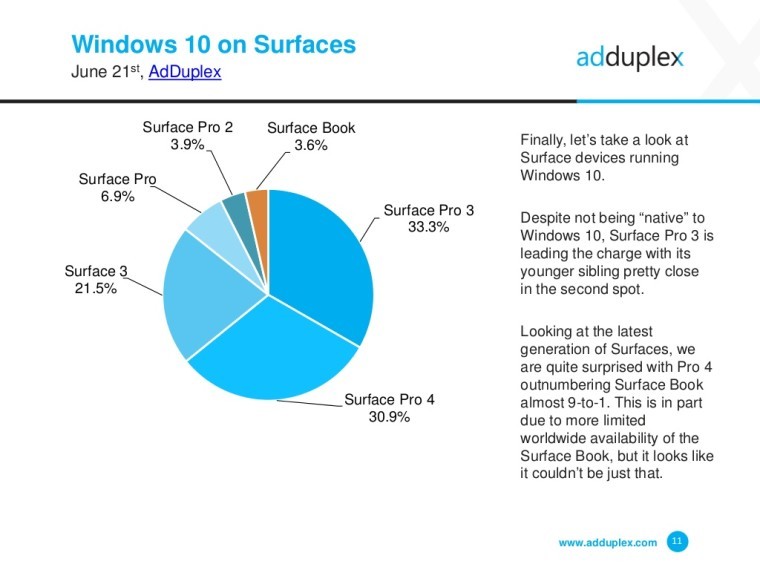
The latest tracking stats for Windows phones have been released by advertising network AdDuplex, which monitors usage across its network to create a detailed monthly breakdown of Microsoft's mobile ecosystem. Each month, the reports capture a snapshot of worldwide usage across one 24-hour period - in this case, June 21, 2016.

Windows 10 Mobile has increased its share of the ecosystem compared with last month, and is now installed on 10.9% of active Windows devices. However, that represents growth of just 0.5% in the last few weeks, compared with an increase of 1.2% during the previous month.
It's also worth noting that none of the latest growth came from upgrades from earlier versions of the OS. Windows Phone 8.1 is still on 78.8% of devices - identical to last month. Declines in WP7 and WP8 usage matched the modest increase in Windows 10 Mobile's platform share, but since there's no direct upgrade path from these older versions to the newest release, that growth appears to have come from sales of new Windows 10 handsets.
There are two points to bear in mind here. First, as AdDuplex notes, it seems that most of those users with devices eligible to upgrade to Windows 10 Mobile, and who wanted to do so, have done so already. Microsoft isn't 'pushing' the upgrade to Windows Phone 8.1 users, but is instead requiring users to opt in. This has obviously left many users unaware that the update is even available for their devices - particularly those who don't routinely monitor tech news sites - further limiting Windows 10 Mobile's growth.
That brings us to the second point: even if the 0.5% monthly growth has come entirely from the sale of new Windows 10 Mobile handsets, we already know from the plummeting market share of the OS that sales of those devices are extremely small. So while it's encouraging that new handsets are continuing to be sold, they're clearly not being sold in any significant numbers.

AdDuplex also published a detailed breakdown of the top 10 handsets running Windows 10 Mobile. Of the 10.9% handsets running the new OS, the Lumia 535 is most widely used at 13.4%, followed by the newer Lumia 640 on 11.9%.
The Lumia 550 - the most affordable handset to ship with Windows 10 Mobile pre-installed - is close behind on 11.2%. The Lumia 650, 950 and 950 XL - all of which also ship with the new OS onboard - are in 7th, 5th, and 9th places respectively.
There are no Windows 10 Mobile devices from Microsoft's hardware partners in the top 10.

That's not at all surprising, given that Lumia handsets continue to dominate the Windows ecosystem. For the last two years, Nokia/Microsoft devices have accounted for around 95% or more of all Windows phones, and that figure has remained at closer to 97% for the last few months.
Last July, Microsoft announced plans to massively scale back its phone hardware portfolio to make room for its partners to sell more of their Windows handsets. A year later, that strategy doesn't appear to be working, as non-Lumia devices still aren't making up the difference as expected. Data from Gartner suggests that the company's partners sold a combined total of just 100,000 Windows phones around the world during the entire first quarter of this year.

The chart above certainly seems to support Gartner's data. Despite scaling back its range of phones to just a handful of models, Microsoft accounts for almost 99% of all Windows 10 Mobile devices (including both brand new handsets and those that upgraded to the new OS).
With sales of the Lumia range collapsing by 73% year-over-year, and sales of its partners' handsets remaining extremely low, things continue to look bleak for Microsoft's mobile ecosystem.

In an unusual departure from its standard practice, AdDuplex also published details of Windows 10 PC manufacturers in its latest report.
Note that the chart below doesn't represent sales of devices, but rather the proportion of active devices from each manufacturer running Windows 10.

HP is in a distant first place with over 22% of devices running Windows 10, followed far behind by Dell with 12.42%, and Lenovo on around 11%. Microsoft's Surface range is well behind the market leaders, making up 3% of Windows 10 devices.

And here's the breakdown of Surface devices running Windows 10. Between them, the Surface Pro 3 and the newer Pro 4 account for almost two-thirds of Microsoft devices running its latest OS. Remarkably, as AdDuplex notes, the Pro 4 outnumbers the Surface Book - which was unveiled at the same time - by a staggering 9-to-1.
You can check out the full summary of this month's AdDuplex report here, and the detailed monthly report will be published tomorrow on the AdDuplex blog.
Editor's note: This article was updated after publishing to remove a duplicate chart.

















23 Comments - Add comment